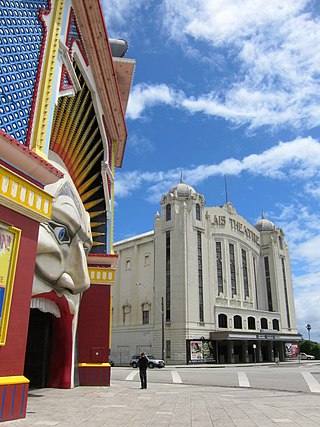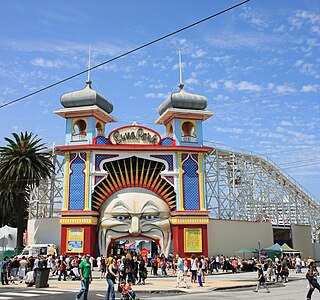
Walter Burley Griffin was an American architect and landscape architect. He designed Canberra, Australia's capital city, the New South Wales towns of Griffith and Leeton, and the Sydney suburb of Castlecrag.

St Kilda is an inner seaside suburb in Melbourne, Victoria, Australia, 6 km south-east of the Melbourne central business district, located within the City of Port Phillip local government area. St Kilda recorded a population of 19,490 at the 2021 census.

Arts Centre Melbourne, originally known as the Victorian Arts Centre and briefly called the Arts Centre, is a performing arts centre consisting of a complex of theatres and concert halls in the Melbourne Arts Precinct, located in the central Melbourne suburb of Southbank in Victoria, Australia.

Dance hall in its general meaning is a hall for dancing, but usually refers to a specific type of twentieth-century venue, with dance clubs (nightclubs) becoming more popular towards the end of the century. The palais de danse was a term applied to purpose-built dance halls in Britain and Commonwealth countries, which became popular after the First World War.

Luna Park Melbourne is a historic amusement park located on the foreshore of Port Phillip Bay in St Kilda, Melbourne, Victoria. It opened on 13 December 1912, with a formal opening a week later, and has been operating almost continuously ever since.

Tourism is a significant industry in the state of Victoria, Australia. The country's second most-populous city, Melbourne was visited by 2.7 million international overnight visitors and 9.3 million domestic overnight visitors during the year ending December 2017.

The Esplanade Hotel, commonly known locally as "The Espy", is a hotel and music venue in the inner bayside suburb of St Kilda, in the city of Melbourne, Victoria, Australia. Built in 1878, it overlooks Port Phillip from the Upper Esplanade. It is famed for its long history of live music, and served as the filming location for the live music trivia program Rockwiz.

The Capitol is a theatre on Swanston Street in the central business district (CBD) of Melbourne, Victoria, Australia. Opened in 1924 as part of the Capitol House building, the theatre was designed by American husband and wife architects Walter Burley Griffin and Marion Mahony Griffin. It is the oldest of Melbourne's large picture palaces and is known for its extravagant decor and abstract motifs, including an intricate geometric ceiling containing thousands of coloured lights designed to evoke the walls of a crystalline cave.

The Palais Theatre, formerly known as Palais Pictures, is a historic picture palace located in St Kilda, an inner suburb of Melbourne, Victoria, Australia. With a capacity of nearly 3,000 people, it is the largest seated theatre in Australia.
St Kilda Beach is a beach located in St Kilda, Port Phillip, Victoria, Australia, 6 kilometres (3.7 mi) south from the Melbourne city centre. It is Melbourne's most famous beach. The beach is a sandy beach about 700 metres (2,300 ft) long between St Kilda Marina and St Kilda Harbour along Jacka Boulevard and St Kilda Esplanade. It is located at the north-east corner of Port Phillip and is protected from ocean swell, though still affected by strong westerly winds. With Port Phillip Bay being open to the sea, St Kilda Beach is subject to regular tides.
Antony John Jereos Lekatsas (1862–1946), best remembered as Anthony J. J. Lucas, was an influential Australian businessman noted for his philanthropic activities and as proprietor and developer of a number of noted entertainment and restaurant ventures in Melbourne, Australia in the early 20th century. Lucas became the Greek Consul General to Australia in 1921, then Consul in Melbourne in 1931–46.
A Music Victoria study finds Melbourne hosts 62,000 live concerts annually, making it one of the live music capitals of the world. Victoria is host to more than three times the live performance national average, making it the live music capital of the country. Melbourne is host to more music venues per capita than Austin, Texas.
A palais de danse may refer to:
Isidor George Beaver, sometimes misspelt "Isidore" and "Beevor", and frequently initialised as "J. G. Beaver", was an architect from England who had a substantial career in Adelaide, South Australia and Melbourne, Victoria. He was also significant in the early history of ice skating in Australia.

The St. Moritz Ice Rink, built as the Wattle Path Palais de Danse in 1923 and then used as Efftee Studios from 1933, was an ice rink on The Esplanade, St. Kilda, Victoria, which operated between 1939–1981. Opened as St. Moritz Ice-skating Palais, as one of only two ice rinks in Melbourne in the 40s and 50s, it played a central role to the sport of ice hockey in Australia. Closed in 1982, it soon suffered a major fire and was then demolished, an event later seen as a major blow to the heritage of St Kilda.
William Arthur Purnell FRAIA, generally known as Arthur Purnell, and sometimes A W Purnell, was an Australian-born architect who practised in Canton, China, in the 1900s, and from 1910 mainly in Melbourne, Australia. He is most noted for the few designs in Melbourne that include Chinese references.

Henry Eli White, also known as Harry White, was a New Zealand-born architect best known for the many theatres and cinemas he designed in New Zealand and Australia in the 1910s and 1920s. Many of the major surviving historic venues in the two countries are White designs, including the St. James Theatre, Wellington, St. James Theatre, Auckland, the Capitol Theatre and State Theatre in Sydney, and the Palais Theatre and the interiors of the Princess Theatre and Athenaeum Theatre in Melbourne. He also designed the City Hall and the attached Civic Theatre in Newcastle, New South Wales.
Henry Osborne Jacobs was an English musician best known as an accompanist, arranger and conductor for Ada Reeve, then settled in Australia, where he had a substantial career.














